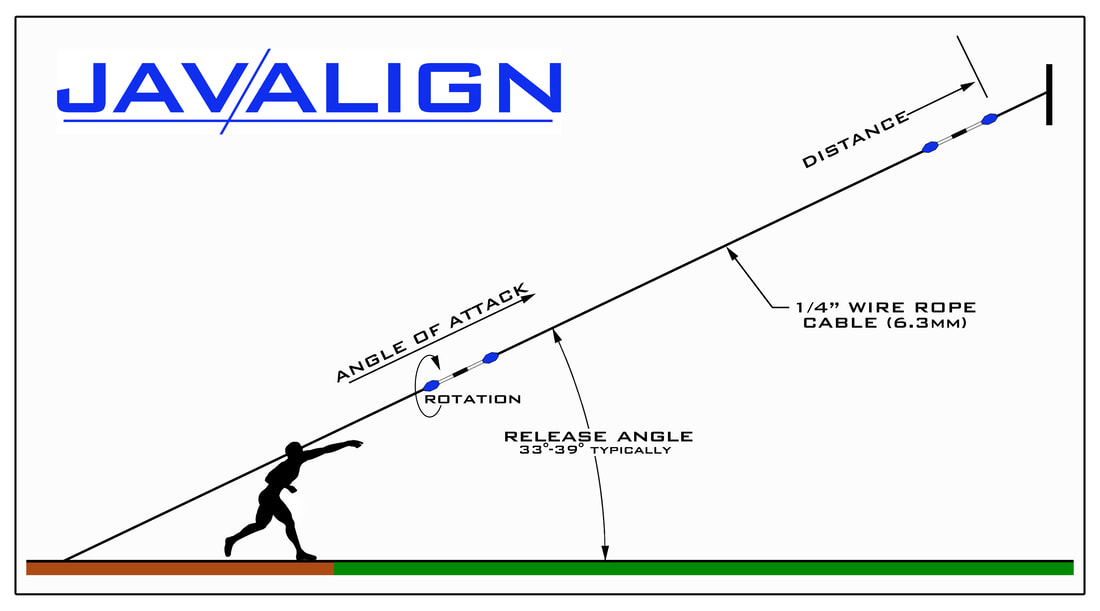Training Concept
|
The training benefit of the Javalign is in it's name. Align. For the most efficient and farthest throws, alignment is essential. A vector is a term that is used to describe a force with a specific direction. A javelin during flight has an optimum vector path for a long throw. The direction of the thrown javelin vector must align with the Release Angle and align with the proper Angle of Attack. Spin is also introduced into the javelin to help with aerodynamic stability. This is a rotational vector. The Javalign is a training tool that provides proper repetitive mechanical motion to help the thrower release the javelin with the correct Release Angle and Angle of Attack while providing sufficient rotation. Repetitive exercises are the key to promoting muscle memory which leads to more effortless throws with consistent technique.
|
RELEASE ANGLE,The main vector for a javelin travels along the Release Angle trajectory which is measured from the ground. If you look at the diagram above you can see that this angle is typically between 33° and 39° depending on the preference and physiological mechanics of individual throwers. This is the flight path at the release point relative to the ground. Consistent throws at the athlete's optimum Release Angle will result in the thrower's maximum distance throw after throw. Throwing the Javalign along the wire rope at a pre-set Release Angle reinforces the correct body positioning and movement resulting in subconscious and properly aligned throwing mechanics.
|
ANGLE OF ATTACKThe Angle of Attack is a vector direction of the grip after release relative to the linear direction of the javelin along its Released Angle. The ideal Angle of Attack is 0° with respect to the Release Angle trajectory at the moment of release. This is commonly referred to as "throwing through the point." The idea it to throw the center of mass of the javelin through its axial direction. If the center of mass is thrown under the javelin's axil center, the result is a rise of the tip during flight. If the center of mass is thrown over the javelin's axial center then the tip falls rapidly. Both of these scenarios greatly increase wind resistance and reduce throw distance.
Likewise, there is a horizontal Angle of Attack which reacts with the javelin's flight in the same way. If the center of mass is thrown to the right of the javelin's axil center the javelin will point left during flight, and vis versa when throwing center of mass to the left. This is evident when you see the javelin land in the ground pointed either left or right from the straight direction it was thrown. When throwing the Javalign up the wire rope cable it is felt through the grip if the Angle of Attack is concentric with the cable Release Angle. The cable oscillates proportionally to the offset Angle of Attack during the throw. The higher the Angle of Attack the more oscillation. It provides instant visual feed back on whether or not you are "throwing through the point." A clean throw with zero Angle of Attack will provide a very smooth and linear ride of the Javalign up the wire rope cable. This is accomplished by the internal ball bearings that are installed and positioned with precision. |
ROTATIONRotation is a very important aspect to javelin flight stability. Rotation of the javelin helps stabilize the oscillations (wobble) from the release which in turn straightens the path and reduces wind resistance. The Javalign has blue fins on both ends that are specifically designed to provide visual feedback as to the amount of rotation imparted on the Javalign. The diameter and grip are near perfect representations of an actual javelin in order to provide the athlete with the most realistic training experience and have mechanical muscle memory translate perfectly into an actual javelin throw in competition.
|






